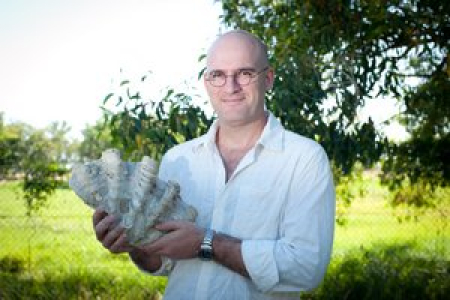New species of giant clam discovered
Research surveying the Northern Territory’s coastline for a threatened giant clam has uncovered a previously unknown species.
Charles Darwin University’s Shane Penny was working on his PhD when he co-discovered the yet-to-be-named species in Western Australian waters. He is now working with a team from the University of Queensland to describe the species.
“What we found, is known as a cryptic species,” Mr Penny said. “This means it looks very similar to one or more common giant clam species but they are genetically distinct.
“The greatest significance of this new cryptic species is that it casts doubt on the validity of the ‘historical’ giant clam species defined solely on conchological characteristics and could have a significant impact of the conservation status of giant clam species.”
Mr Penny detected the new species while analysing genetic tissue samples as part of his PhD research to establish the conservation status of giant clams in the NT.
“There was very little information about giant clams inhabiting the NT’s coastline, with only a dozen museum records and as yet undocumented traditional knowledge,” he said.
“The cryptic species serendipitously turned up while I was sequencing some tissue samples collected by a colleague on my behalf. I then visited the site in Ningaloo to collect a specimen and some fresh tissue samples.”
Mr Penny has found there are more species of giant clam in northern waters than was previously thought.
“Previous to this study it was thought that only one species of giant clam was found in the NT, Tridacna squamosa (the fluted giant clam), which has an elaborately striped or spotted fleshy mantle, large leaf-like fluted ribs on its shell and can grow to almost half a meter,” Mr Penny said.
“By collaborating with Indigenous people and conducting video surveys and tissue biopsies we are looking into aspects of their ecology and population genetics and finding a lot of new information about the species.
“So far I have been able to confirm there are four species in the NT.”
He said understanding the diversity of giant clams had important consequences for conservation and future management of the species.
“Misidentifying species, can lead to an over-estimation of their abundance,” he said. “We may think we are dealing with a single species when in fact we might be surveying more species that are less abundant.”
Mr Penny said that despite protection under international treaties, giant clams continued to be harvested and were rapidly becoming locally extinct near easily accessible sites, particularly in South-east Asia.
Mr Penny co-authored the original paper identifying a new species alongside researchers from the University of Queensland. For more information visit: www.plosone.org/article/info%3Adoi%2F10.1371%2Fjournal.pone.0080858
He is now working to name the species.
